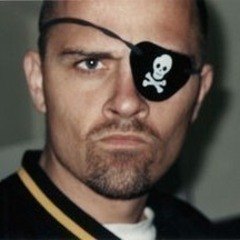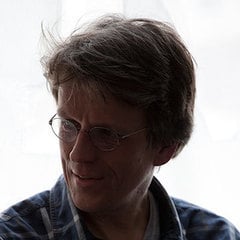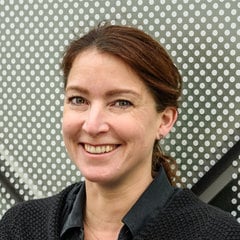Discover legacy content from FontShop.com, preserved for your reference.
I was introduced to the Berlage project when Donald Beekman presented it at the first TypeAmsterdam in 2010. Its story began almost three decades ago. In 1987 the Beurs van Berlage, the building by iconic Dutch architect and urban designer Hendrik Pieter Berlage (°1856 – †1934) that once housed the Amsterdam Stock Exchange was being renovated. Donald’s colleague and friend Bert Dautzenberg participated in a pitch for the visual identity of the new bar located in the building. He asked Donald if he could help him turn into a font the letters integrated into the architecture of the building. Dautzenberg failed to win the pitch, and the design remained as good as untouched until the early 2000s. Around that time Donald Beekman – who by then had become an established typeface designer with a good number of display faces under his belt – felt the need for “a little less output and a bit more input,” to use his own words. He decided to embark on a research project.

From Boat to Bridge to Berlage
Donald lives in a houseboat that doubles as his graphic and audiovisual design studio DBXL. It is moored in the river Amstel near the Berlagebrug, the Bridge by Berlage, which he crosses a couple of times a day. The name of the bridge is carved into the stone, and Donald naively thought that, as the bridge was designed by Berlage, the letters would also be his work. His investigations, however, revealed that this was not the case: they were probably drawn by Piet Kramer or Anton Kurvers, both representatives of the Amsterdamse School movement. As Donald went deeper and deeper down the rabbit hole, he was reminded of the font he once created with Bert Dautzenberg. With the blessing of Dautzenberg, Donald picked up where he left off on the typeface design.




Motivated to create the definitive Berlage typeface, Donald went on a search for a good representation of the alphabet. There existed some Art Nouveau fonts that were similar, but no faithful digital version of this particular style of Dutch School lettering. Donald started taking pictures and talking to people, visited the Special Collections of the Amsterdam University, and cruised the city by bicycle in search for examples of the letters. Unfortunately, the whole project started to lose steam. Donald mostly encountered instances of a different style than the typical Dutch School, the kind with their typical high waist, raised middle horizontal bar, often square-topped capital ‘A’, and so on; all designed by other architects and artists. Very few were based on the rectangle with rounded corners, the core shape of the letters found in the stock exchange building that served as a reference. Little did Donald know back then that those variations were typical for the lettering tradition the alphabet was steeped in. Even though the research project was educational, it became tiresome because Donald felt he did not make any real progress.
‘Beispiele Künstlerischer Schrift‘
The breakthrough in Donald’s quest came from an unexpected source. On the website of Belgian mathematician typographer Luc Devroye, Donald found some scans from the series Beispiele Künstlerischer Schrift by Rudolf von Larisch, the calligrapher and typographer associated with the Wiener Werkstätte. These booklets, published at the turn of the previous century, collected alphabets by a number of pan-European artists, designers, architects,… When Donald saw Berlage’s name on a content page, he emailed Devroye who referred him to the Klingspor Museum in Offenbach. The museum had the booklets in their collection and provided Donald with a scan of the relevant page. To his surprise and delight, the specimen page showed a complete Berlage alphabet featuring every single characteristic letterform that Donald had found so far, and more. He concluded the letters on the specimen page must have been what Berlage considered to be “good typography,” and as such could serve as the mother lode for his typeface design. You have to understand Berlage was more than merely an architect; in his days he was regarded as an example, a kind of ‘godfather’ who in large part defined the design of his time. His influence transcended the field of architecture and spilled into other disciplines like typography. Also, in his heyday, Berlage employed a staggering 150 people, so it is likely that he had employees on staff who were proficient at drawing alphabets.
Beurs and Burcht
The letterforms on the page from the Beispiele Künstlerischer Schrift booklet, together with the many geometric alternates he had already discovered in his previous research, enabled Donald to draw a completely revised Berlage alphabet. After a while, he realised he had, in fact, drawn more than enough glyph shapes for two FF Berlage typefaces, each with their own distinct flavour – Beurs and Burcht. The project basically doubled in magnitude.


The basic shape for the FF Berlage Beurs typeface is a rectangle with rounded corners. Its forms are based on the letters integrated into the interior of the Beurs van Berlage. On the second floor, the alphabet is used in moralistic sayings running along the tiled frieze. Judging by the photographs sent by his friend Bert Dautzenburg, Donald thought every letter occupied one tile, but the lettering proved to be much more sophisticated. The sayings themselves all express decidedly socialist sentiments. This is quite surprising for the stock exchange, the personification of capitalism. Berlage being a socialist at heart, he probably used these texts to incorporate his personal convictions into the building he designed.


The other building is the Bondsgebouw ANDB (also called ‘Burcht’), the building of the General Dutch Diamond Cutters’ Union in Amsterdam. In that building, Donald discovered a stone slab with an engraved inscription, donated by the French equivalent of the Dutch union. The slab features 90% of the alternative shapes with the circular round letters that Donald found during his investigations. This made Donald decide to use Burcht as the name for his second Berlage font family.
Taking Berlage to the Type Board
In 2008 Donald submitted his Berlage typeface to the FontFont Type Board, to test the waters. The reaction was positive, and the Type Board encouraged him to further develop the family. They suggested that, because the alphabet was based on lettered models, including the ligatures and nested letters that are so typical to lettering would be fitting. Donald went a little overboard, drawing 800 ligatures over the following year, some of them consisting of up to six consecutive letters. He finally came to the realisation this made no sense. At the following Type Board he was told that, while this was a lot of fun, his typeface had become impossible to kern or track. Łukasz Dziedzic came to the rescue, advising Donald to divide the ligatures into separate components that could be reassembled.

[link not found]
Beyond the core character sets for the Beurs and Burcht variants, Donald found even more letterforms – in books by Berlage, in his furniture and his architecture. He collected and organised all these different forms. Evidently, there are not many options for an ‘I’, but letters like the ‘G’ for example came in six to seven variants. Donald was unsure which exact forms to include in the fonts. Type Board member Erik van Blokland helped him by asking Donald what he really wanted to produce – an exhaustively researched, historically correct, ‘archaeological’ typeface faithfully incorporating every single quirk, or a useful typographic tool. He convinced Donald to use his personal artistic judgment to make the type family his own, while still respecting the source material. This makes the FF Berlage typefaces join the ranks of other great examples of typographic archaeology like Verena Gerlach’s FF Karbid® super family or ReType’s Krul. Donald considers this his personal tribute to Hendrik Pieter Berlage, the man who conceived and planned the entire south side of Amsterdam where he lives. This was not limited to the architecture – Berlage embodies the Renaissance ideals, crossing the boundaries between disciplines, and designing from a macro level down to the most minute details in his buildings and furniture.

Eventually, the Berlage project ended up far exceeding Donald’s original plan of simply hunting down examples of letters, snapping pictures and rummaging through archives, something he had never done before. While he had started this without a clear aim, within a year he had a goal: to create the first digital Berlage alphabet. Eventually, the design and research project turned into a ten-year-long learning process, that also saw Donald learning to build advanced typographic features into OpenType fonts, an aspect of type design he previously had not given that much thought to. When asked if he wasn’t intimidated by the scope of this epic project, Donald replied that – if he had known what he was embarking upon more than a decade ago – he probably wouldn’t have done it. He innocently and almost accidentally rolled into this odyssey, which then started to lead a life of its own and gradually blew out of proportion. This has given Donald tremendous respect for people like Jo De Baerdemaeker, Ramiro Espinoza, or Piet Schreuders, who are so dedicated and so thorough in their research, to the point of almost elevating it to an artform. He is also very grateful to all the people who have guided him, given him tips, and brought him into contact with specialists who could help him.
And we are grateful Donald had no idea what epic journey he embarked upon when he began inquiring the Berlage letters, because we now have these two striking display families to work and play with.


